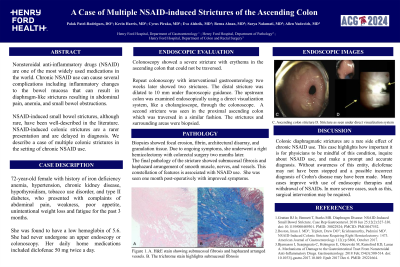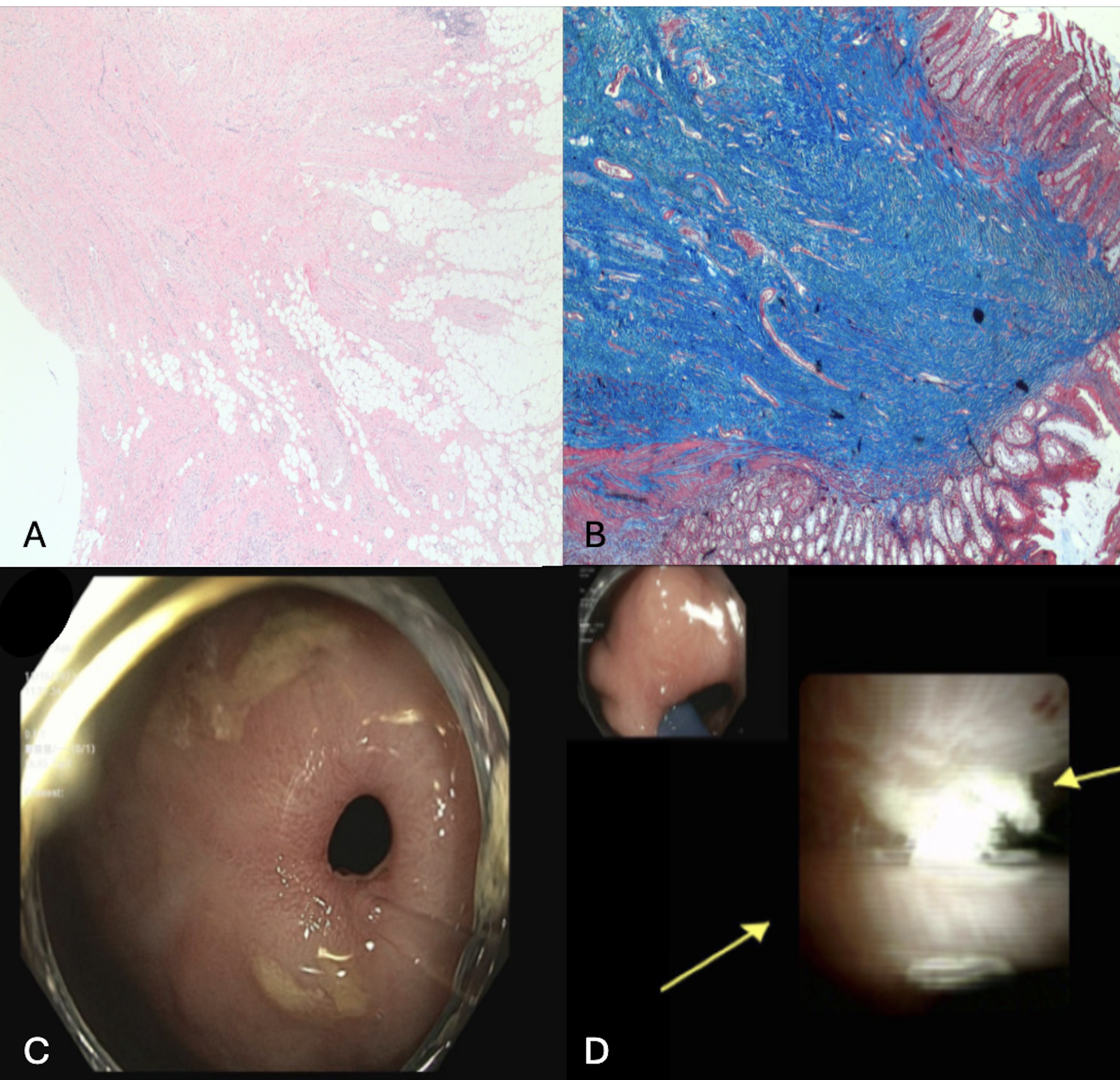Monday Poster Session
Category: Colon
P2080 - A Case of Multiple NSAID-Induced Strictures of the Ascending Colon
Monday, October 28, 2024
10:30 AM - 4:00 PM ET
Location: Exhibit Hall E

Has Audio
- PP
Palak Patel-Rodrigues, DO
Henry Ford Health
Detroit, MI
Presenting Author(s)
Award: Presidential Poster Award
Palak Patel-Rodrigues, DO, Kevin Harris, MD, Cyrus Piraka, MD, Eva Alsheik, MD, Beena Ahsan, MD, Surya Nalamati, MD, Allen Yudovich, MD
Henry Ford Health, Detroit, MI
Introduction: Nonsteroid anti-inflammatory drugs (NSAID) are one of the most widely used medications in the world. Chronic NSAID use can cause several complications including inflammatory changes to the bowel mucosa that can result in diaphragm-like strictures resulting in abdominal pain, anemia, and small bowel obstructions. NSAID-induced small bowel strictures, although rare, have been well-described in the literature. NSAID-induced colonic strictures are a rarer presentation and are delayed in diagnosis. We describe a case of multiple colonic strictures in the setting of chronic NSAID use.
Case Description/Methods: A 72-year-old female with iron deficiency anemia presented with abdominal pain, weight loss, and fatigue for 3 months and was found to have a hemoglobin of 5.6. She had never undergone an upper endoscopy or colonoscopy. Her daily medications included diclofenac 50 mg twice a day. CT of her abdomen showed circumferential wall thickening of the terminal ileum and ileocecal valve. Colonoscopy showed a severe stricture with erythema in the ascending colon that could not be traversed. Repeat colonoscopy with interventional gastroenterology two weeks later showed two strictures. The distal stricture was dilated to 10 mm under fluoroscopic guidance. The upstream colon was examined endoscopically using a direct visualization system, like a cholangioscope, through the colonoscope. A second stricture was seen in the proximal ascending colon which was traversed in a similar fashion. The strictures and surrounding areas were biopsied. Biopsies showed focal erosion, fibrin, architectural disarray, and granulation tissue. Due to ongoing symptoms, she underwent a right hemicolectomy with colorectal surgery two months later. The final pathology of the stricture showed submucosal fibrosis and haphazard arrangement of smooth muscle, nerves, and vessels. This constellation of features is associated with NSAID use. She was seen one month post-operatively with improved symptoms.
Discussion: Colonic diaphragmatic strictures are a rare side effect of chronic NSAID use. This case highlights how important it is for physicians to be mindful of this condition, inquire about NSAID use, and make a prompt and accurate diagnosis. Without awareness of this entity, diclofenac may not have been stopped and a possible incorrect diagnosis of Crohn's disease may have been made. Many cases improve with use of endoscopic therapies and withdrawal of NSAIDs. In more severe cases, such as this, surgical intervention may be required.

Disclosures:
Palak Patel-Rodrigues, DO, Kevin Harris, MD, Cyrus Piraka, MD, Eva Alsheik, MD, Beena Ahsan, MD, Surya Nalamati, MD, Allen Yudovich, MD. P2080 - A Case of Multiple NSAID-Induced Strictures of the Ascending Colon, ACG 2024 Annual Scientific Meeting Abstracts. Philadelphia, PA: American College of Gastroenterology.
Palak Patel-Rodrigues, DO, Kevin Harris, MD, Cyrus Piraka, MD, Eva Alsheik, MD, Beena Ahsan, MD, Surya Nalamati, MD, Allen Yudovich, MD
Henry Ford Health, Detroit, MI
Introduction: Nonsteroid anti-inflammatory drugs (NSAID) are one of the most widely used medications in the world. Chronic NSAID use can cause several complications including inflammatory changes to the bowel mucosa that can result in diaphragm-like strictures resulting in abdominal pain, anemia, and small bowel obstructions. NSAID-induced small bowel strictures, although rare, have been well-described in the literature. NSAID-induced colonic strictures are a rarer presentation and are delayed in diagnosis. We describe a case of multiple colonic strictures in the setting of chronic NSAID use.
Case Description/Methods: A 72-year-old female with iron deficiency anemia presented with abdominal pain, weight loss, and fatigue for 3 months and was found to have a hemoglobin of 5.6. She had never undergone an upper endoscopy or colonoscopy. Her daily medications included diclofenac 50 mg twice a day. CT of her abdomen showed circumferential wall thickening of the terminal ileum and ileocecal valve. Colonoscopy showed a severe stricture with erythema in the ascending colon that could not be traversed. Repeat colonoscopy with interventional gastroenterology two weeks later showed two strictures. The distal stricture was dilated to 10 mm under fluoroscopic guidance. The upstream colon was examined endoscopically using a direct visualization system, like a cholangioscope, through the colonoscope. A second stricture was seen in the proximal ascending colon which was traversed in a similar fashion. The strictures and surrounding areas were biopsied. Biopsies showed focal erosion, fibrin, architectural disarray, and granulation tissue. Due to ongoing symptoms, she underwent a right hemicolectomy with colorectal surgery two months later. The final pathology of the stricture showed submucosal fibrosis and haphazard arrangement of smooth muscle, nerves, and vessels. This constellation of features is associated with NSAID use. She was seen one month post-operatively with improved symptoms.
Discussion: Colonic diaphragmatic strictures are a rare side effect of chronic NSAID use. This case highlights how important it is for physicians to be mindful of this condition, inquire about NSAID use, and make a prompt and accurate diagnosis. Without awareness of this entity, diclofenac may not have been stopped and a possible incorrect diagnosis of Crohn's disease may have been made. Many cases improve with use of endoscopic therapies and withdrawal of NSAIDs. In more severe cases, such as this, surgical intervention may be required.

Figure: Figure 1. A. H&E stain showing submucosal fibrosis and haphazard arranged vessels. B. The trichrome stain highlights submucosal fibrosis. C. Ascending colon stricture D. Stricture as seen under direct visualization system
Disclosures:
Palak Patel-Rodrigues indicated no relevant financial relationships.
Kevin Harris indicated no relevant financial relationships.
Cyrus Piraka: Aries and US Endoscopy – Grant/Research Support. NIH – Grant/Research Support.
Eva Alsheik indicated no relevant financial relationships.
Beena Ahsan indicated no relevant financial relationships.
Surya Nalamati indicated no relevant financial relationships.
Allen Yudovich indicated no relevant financial relationships.
Palak Patel-Rodrigues, DO, Kevin Harris, MD, Cyrus Piraka, MD, Eva Alsheik, MD, Beena Ahsan, MD, Surya Nalamati, MD, Allen Yudovich, MD. P2080 - A Case of Multiple NSAID-Induced Strictures of the Ascending Colon, ACG 2024 Annual Scientific Meeting Abstracts. Philadelphia, PA: American College of Gastroenterology.

